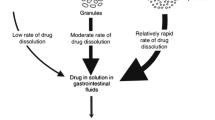Abstract
The present study was designed to investigate the effect of two plasticizers, i.e., triethyl citrate (TEC) and polyethylene glycol 6000 (PEG 6000) on the in vitro release kinetics of diclofenac sodium from sustained-release pellets. Ammonio methacrylate copolymer type B (Eudragit RS 30 D) is used as the release-retarding polymer. Both plasticizers were used at 10% and 15% (w/w) of Eudragit RS 30 D. Pellets were prepared by powder layering technology and coated with Eudragit RS 30 D by air suspension technique. Thermal properties of drug and drug-loaded beads were studied using differential scanning calorimeter (DSC). DSC thermogram represented the identity of raw materials and exhibited no interaction or complexation between the active and excipients used in the pelletization process. Dissolution study was performed by using USP apparatus 1. No significant difference was observed among the physical properties of the coated pellets of different batches. When dissolution was performed as pure drug, about 8.22% and 90% drug was dissolved at 2 h in 0.1 N HCl and at 30 min in buffer (pH 6.8), respectively. From all formulations, the release of drug in acid media was very negligible (maximum 1.8 ± 0.08% at 2 h) but in buffer only 12% and 30% drug was released at 10 h from coated pellets containing TEC and PEG 6000, respectively, indicating that Eudragit RS 30 D significantly retards the drug release rate and that drug release was varied according to the type and amount of plasticizers used. The amount of TEC in coating formulation significantly effected drug release (p < 0.001), but the effect of PEG 6000 was not significant. Formulations containing PEG 6000 released more drug (98.35 ± 2.35%) than TEC (68.01 ± 1.04%) after 24 h. Different kinetic models like zero order, first order, and Higuchi were used for fitting drug release pattern. Zero order model fitted best for diclofenac release in all formulations. Drug release mechanism was derived with Korsmeyer equation.






Similar content being viewed by others
References
B. C. Andrew, and L. Shargel. Applied Biopharmaceutics and Pharmacokinetics, Appleton & Lange, Connecticut, 1941, pp. 225–264.
D. Bidah, and J. M. Vergnaud. Dosage forms with a polymer matrix and a swelling polymer. Int. J. Pharm. 77:81–87 (1991).
S. A. Bravo, M. C. Lamas, and C. J. Salamon. In-vitro studies of diclofenac sodium controlled-release from biopolymeric hydrophilic matrices. J. Pharm. Pharm. Sci. 53:213–219 (2002).
J. L. Ford, A. R. Rajabi-Siahboomi, M. H. Rubinstein, and F. Sadeghi. Comparative study of drug release from pellets coated with HPMC or Surelease. Drug Dev. Ind. Pharm. 266:651–660 (2000).
G. Jayasagar, Y. M. Rao, and J. K. Veni. Formulation and evaluation of diclofenac sodium using hydrophilic matrices. Drug Dev. Ind. Pharm. 278:759–766 (2001).
W. Chuanbin, and W. M. James. Influence of ibuprofen as a solid-state plasticizer in Eudragit® RS 30 D on the physicochemical properties of coated beads. AAPS PharmSciTech. 2(4) article 24 (2001).
L. L. Augsburger, A. Lin, N. A. Muhammad, and D. Pope. Effect of curing and storage conditions on drug release from pellets coated with Eudragit NE30D. AAPS Annual Meeting Supplement 2(4) (2000).
D. Dreher, and K. Lehmann. The use of aqueous synthetic polymer dispersions for coating pharmaceutical dosage forms. Drugs Made Ger. 16:126–136 (1973).
C. E. Obi, and R. S. Okor. Drug release through aqueous-based film coatings of acrylate-methacrylate, a water-insoluble copolymer. Int. J. Pharm. 58:89–91 (1990).
G. Cole (eds.), Pharmaceutical Coating Technology, Taylor & Francis Ltd., London, 2001, pp. 27–31.
J. W. McGinity (eds.), Aqueous Polymeric Coating for Pharmaceutical Dosage Forms, Marcel Decker Inc., New York, 1996, pp. 101–174.
K. Lehmann. Practical Course in Film Coating of Pharmaceutical Dosage Forms with Eudragit, Pharma Polymers, Darmstadt, 2001, pp. 8–15.
Pharmaceutical Coatings Bulletin. Influence of Citrate Ester Plasticizers on the Properties of Acrylic Resin Polymers, Morflex, Inc., 1993, p. 102.
Pharmaceutical Coatings Bulletin. Physical and Mechanical Properties of Acrylic and Cellulosic Polymers Plasticized with Citrate Esters. Morflex, Inc., 1994, p. 102.
USP 23/NF 18. Triethyl Citrate-Official Monograph, 1995, p. 2316.
C. Tapia, Z. Escobar, E. Costa et al. Comparative studies on polyelectrolyte complexes and mixture of chitosan-alginate and chitosan-carrageenan as prolonged diltiazem clorhydrate release system. Eur. J. Pharm. Biopharm. 57:65–75 (2004).
A. G. Gilman, T. W. Rail, A. S. Nies, and P. Taylor. The Pharmacological Basis of Therapeutics, Pergamon Press, New York, 1990.
D. M. Morkhade, S. V. Fulzele, P. M. Satturwar, and S. B. Joshi. Gum copal and gum damar: novel matrix forming materials for sustained drug delivery. Ind. J. Pharm. Sci. 68:53–58 (2006).
T. Higuchi. Mechanism of sustained action medication. Theoretical analysis of rate of release of solid drugs dispersed in solid matrices. J. Pharm. Sci. 52:1145–1149 (1963).
R. W. Korsmeyer, R. Gurny, E. Doelker, P. Buri, and N. A. Peppas. Mechanisms of solute release from porous hydrophilic polymers. Int. J. Pharm. 15:25–35 (1983).
Y. Zhu, K. A. Mehta, and J. W. McGinity. Influence of plasticizer level on the drug release from sustained release film coated and hot-melt extruded dosage forms. Pharm. Dev. Tech. 11:285–294 (2006).
G. Kibria, and R. Jalil. The effect of the ratio of two acrylic polymers on the in-vitro release kinetics of ketoprofen from pellets prepared by extrusion and spheronisation technique. Pak. J. Pharm. Sci. 212:92–97 (2008).
M. F. Saettone, G. Perini, P. Rijli, L. Rodriguez, and M. Cini. Effect of different polymer-plasticizer combinations on in vitro release of theophylline from coated pellets. Int. J. Pharm. 126:83–88 (1995).
Acknowledgements
The authors would like to thank Eskayef Bangladesh Ltd. (formerly, SmithKline & French, UK) for providing the raw materials as well as manufacturing facilities, Bangladesh Council of Scientific and Industrial Research (BCSIR), and Renata Ltd. Bangladesh (formerly, Pfizer, USA) for providing the scanning electron micrograph and the DSC thermogram, respectively.
Author information
Authors and Affiliations
Corresponding author
Rights and permissions
About this article
Cite this article
Kibria, G., Roni, M.A., Absar, M.S. et al. Effect of Plasticizer on Release Kinetics of Diclofenac Sodium Pellets Coated with Eudragit RS 30 D. AAPS PharmSciTech 9, 1240–1246 (2008). https://doi.org/10.1208/s12249-008-9163-4
Received:
Accepted:
Published:
Issue Date:
DOI: https://doi.org/10.1208/s12249-008-9163-4




